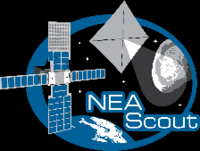 NEA Scout concept: a controllable CubeSat solar sail spacecraft | |
| Names | NEA Scout |
|---|---|
| Mission type | Technology demonstrator, Reconnaissance |
| Operator | NASA |
| COSPAR ID | 2022-156H |
| SATCAT no. | 57684 |
| Mission duration | 2.5 years (planned) 2 days (final) |
| Spacecraft properties | |
| Spacecraft type | CubeSat |
| Bus | 6U CubeSat |
| Launch mass | 14 kg (31 lb) [1] |
| Dimensions | 10 cm × 20 cm × 30 cm (3.9 in × 7.9 in × 11.8 in) Solar sail: 85 m2 (910 sq ft) [2] |
| Start of mission | |
| Launch date | 16 November 2022, 06:47:44 UTC[3] |
| Rocket | SLS Block 1 |
| Launch site | KSC, LC-39B[4] |
| Contractor | NASA |
| End of mission | |
| Last contact | Never established |
| Orbital parameters | |
| Reference system | Heliocentric orbit |
| Transponders | |
| Band | X-band |
| TWTA power | 2 watts |
 NEA Scout Mission Patch | |
The Near-Earth Asteroid Scout (NEA Scout) was a mission by NASA to develop a controllable low-cost CubeSat solar sail spacecraft capable of encountering near-Earth asteroids (NEA).[5][6] NEA Scout was one of ten CubeSats launched into a heliocentric orbit on Artemis 1, the maiden flight of the Space Launch System, on 16 November 2022.[3][7]
The target for the mission was asteroid 2020 GE,[8] but this could have changed based on launch date or other factors.[9] After deployment, NEA Scout was to perform a series of lunar flybys to achieve optimum departure trajectory before beginning its two-year-long cruise.
No contact with the spacecraft was ever made, and the mission was lost.[10]
- ^ Cite error: The named reference
Sobey 2016was invoked but never defined (see the help page). - ^ Cite error: The named reference
FTUwas invoked but never defined (see the help page). - ^ a b Roulette, Joey; Gorman, Steve (16 November 2022). "NASA's next-generation Artemis mission heads to moon on debut test flight". Reuters. Retrieved 16 November 2022.
- ^ Hill, Bill (7 March 2012). "NASA Advisory Council - Exploration Systems Development Status" (PDF). NASA. Archived from the original (PDF) on 31 August 2020. Retrieved 11 March 2021.
 This article incorporates text from this source, which is in the public domain.
This article incorporates text from this source, which is in the public domain.
- ^ "NASA TechPort – Near Earth Asteroid Scout (NEA Scout)". NASA TechPort. NASA. 2015. Archived from the original on 29 November 2020. Retrieved 11 March 2021.
 This article incorporates text from this source, which is in the public domain.
This article incorporates text from this source, which is in the public domain.
- ^ McNutt, Leslie; Castillo-Rogez, Julie (4 August 2014). "Near-Earth Asteroid Scout" (PDF). American Institute of Aeronautics and Astronautics (AIAA). NASA. Retrieved 11 March 2021.
 This article incorporates text from this source, which is in the public domain.
This article incorporates text from this source, which is in the public domain.
- ^ Clark, Stephen (12 October 2021). "Adapter structure with 10 CubeSats installed on top of Artemis moon rocket". Spaceflight Now. Retrieved 22 October 2021.
- ^ "NASA Solar Sail Mission to Chase Tiny Asteroid After Artemis I Launch". Jet Propulsion Laboratory. NASA. 20 January 2022. Retrieved 20 January 2022.
The target is 2020 GE, a near-Earth asteroid (NEA) that is less than 60 feet (18 meters) in size.
- ^ Mahoney, Erin (14 January 2020). "NEA Scout". NASA. Retrieved 11 March 2021.
 This article incorporates text from this source, which is in the public domain.
This article incorporates text from this source, which is in the public domain.
- ^ Dickinson, David (6 December 2022). "Status Update: Artemis 1's SmallSat Missions". Sky & Telescope. Sky&Telescope. Retrieved 8 December 2022.